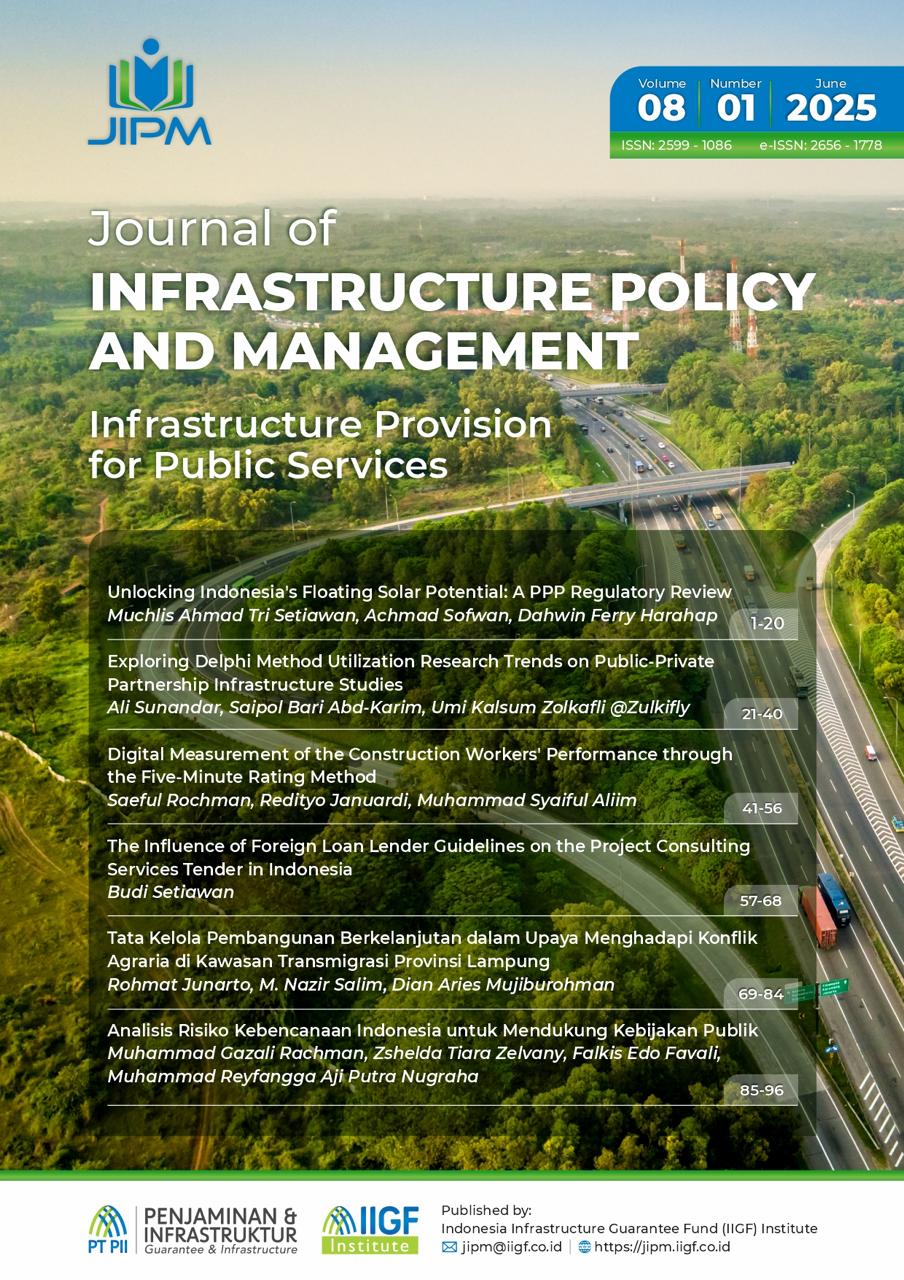Digital Measurement of the Construction Workers’ Performance through the Five-Minute Rating Method
DOI:
https://doi.org/10.35166/jipm.v8i1.98Keywords:
Efficiency, Five-Minute Rating, Digitalization, Labor PerformanceAbstract
The Five-Minute Rating method is a simplified approach used to measure workers’ performance based on time study principles, aimed to provide representative evaluations with minimal observation samples. However, its adoption in the construction industry remains low at only 6.4%, due to perceived impracticality and time-consuming implementation. A digital solution known as the Five-Minute Rating Solver (FMR-Solver), developed as an Android-based application, has been introduced. However, the practicality of its use and the efficiency of the measurement duration have yet to be studied. This study aims to measure the efficiency of the application tool in assessing worker effectiveness compared to using the conventional Five-Minute Rating method and to evaluate users’ perceptions of using the application. A case study was conducted during the installation of foundation reinforcement. The results show that the application tool can increase measurement efficiency by 22.6%. Evaluations by five users—based on criteria of stability, accuracy, understandability, operability, usefulness, and attractiveness—indicate validity scores ranging from 76.0% to 96.0%, falling within the categories of valid to very valid. The results suggest that the method offers a practical and effective alternative for construction workers’ performance and holds promise for wider industry adoption.
References
Abukhalaf, A. H. I., & Abusal, D. (2021). Measuring labor efficiency in green construction projects. Academia Letters, 2. http://doi.org/10.20935/AL3393
Albert, B., & Tullis, T. (2013). Measuring the user experience: Collecting, analyzing, and presenting usability metrics. Newnes.
Amin, M., Rezaei, S., & Abolghasemi, M. (2014). User satisfaction with mobile websites: The impact of perceived usefulness, perceived ease of use, and trust. Nankai Business Review International, 5(3), 258–274. https://doi.org/10.1108/NBRI-01-2014-0005
Aziz. (2023). Studi inisiasi penggunaan metode pengukuran produktivitas metode crew balance chart berbasis mobile application. Universitas Jenderal Soedirman. https://repository.unsoed.ac.id/26504/
Aziz, M. A., Januardi, R., & Aliim, M. S. (2024). Efisiensi penggunaan CBC calculator sebagai alat bantu pengukuran produktivitas metode crew balance chart. Journal of Infrastructure Policy and Management (JIPM), 7(2), 125–138. https://doi.org/10.35166/jipm.v7i2.50
Bevan, N., Carter, J., Earthy, J., Geis, T., & Harker, S. (2016). New ISO standards for usability, usability reports, and usability measures. Human-Computer Interaction. Theory, Design, Development, and Practice: Proceedings of the 18th International Conference, HCI International 2016, Toronto, ON, Canada, July 17-22, 2016, Part I 18, 268–278. https://doi.org/10.1007/978-3-319-39510-4_25
Boakye, M. K., Adanu, S. K., Adu-Gyamfi, C., Asare, R. K., Asantewaa-Tannor, P., Ayimah, J. C., & Agbosu, W. K. (2023). A relative importance index approach to on-site building construction workers’ perception of occupational hazards assessment. La Medicina Del Lavoro, 114(3), 2023024. https://doi.org/10.23749/mdl.v114i3.14240
Brooke, J. (1996). SUS-A quick and dirty usability scale. In P. W. Jordan, B. Thomas, I. L. McClelland, & B. Weerdmeester (eds.), Usability evaluation in industry (pp. 4–7). CRC Press. https://doi.org/10.1201/9781498710411
Dozzi, S. P., & AbouRizk, S. M. (1993). Productivity in construction. Institute for Research in Construction, National Research Council Ottawa. https://nrc-publications.canada.ca/eng/view/ object/?id=52dc96d5-4ba0-40e6-98d2-8d388cba30cd
Farooq, H., & Moon, S. (2019). Comparative study of crew performance measurement methods: Case study of steel fixers. Proceedings of the 22nd International Conference on Advancement of Construction Management and Real Estate, CRIOCM 2017, 772–779. https://doi.org/10.25916/sut.26247950.v1
Hamzan, M. A., Nrartha, I. M. A., & Wiryajati, I. K. (2022). Rancang bangun sistem pemantauan daya listrik berbasis android menggunakan teknologi react native. Dielektrika, 9(1), 42–50. https://doi.org/10.29303/dielektrika.v9i1
Hermawan, I., & Sudirman, S. (2023). Digitalisasi industri konstruksi dengan integrasi BIM dan 3D machine control untuk meningkatkan performa pelaksanaan konstruksi. Jurnal Teknik Sipil, 19(2), 185–203. https://doi.org/10.28932/jts.v19i2.4497
Hoehle, H., & Venkatesh, V. (2015). Mobile application usability. MIS Quarterly, 39(2), 435–472. https://www.jstor.org/stable/26628361
Januardi, R., Dewangga, J. P., & Aliim, M. S. (2025). Penilaian efisiensi aplikasi MPDM calculator dalam pengukuran produktivitas method productivity delay model. Journal of Applied Civil Engineering and Infrastructure Technology, 6(1), 52–58. https://doi.org/10.52158/jaceit.v6i1.1041
Januardi, R., Nugroho, P. S., & Mulyono, B. (2023). Persepsi pengguna dalam mengukur kinerja operasi konstruksi berbasis sampling menggunakan analytical hierarchy process. Jurnal Ilmiah Telsinas Elektro, Sipil, dan Teknik Informasi, 6(2), 112–121. https://doi.org/10.38043/telsinas.v6i2.4517
Januardi, R., Nugroho, P. S., Mulyono, B., & Viqolbi, M. (2024). The effectiveness of construction operation performance measurement techniques and the challenges of application in preventing delays in construction projects. MATEC Web of Conferences, 402, 04002. https://doi.org/10.1051/matecconf/202440204002
Kim, J., Yoon, I., Jung, M., Joo, S., Park, S., Hong, Y., Cho, J., & Park, M. (2022). Establishment of measurement standards for productivity assessment in construction project. Korean Journal of Construction Engineering and Management, 23(3), 3–12. https://doi.org/10.6106/KJCEM.2022.23.3.003
Kurniawan, S. (2004). Interaction design: Beyond human-computer interaction by Preece, Sharp and Rogers. Universal Access in the Information Society, 3, 289. http://doi.org/10.1007/s10209-004-0102-1
Lewis, J. R. (2018). The system usability scale: Past, present, and future. International Journal of Human-Computer Interaction, 34(7), 577–590. https://doi.org/10.1080/10447318.2018.1455307
Loukatos, D., Kondoyanni, M., Kyrtopoulos, I.-V., Kiriakos, D. E., Psaromiligkos, Y., & Arvanitis, K. G. (2024). Innovative STEM practices fostering the digital transformation of agriculture: The STEM4Agri paradigm. 2024 IEEE Global Engineering Education Conference (EDUCON), 1–9. https://doi.org/10.1109/EDUCON60312.2024.10578935
Moumane, K., Idri, A., & Abran, A. (2016). Usability evaluation of mobile applications using ISO 9241 and ISO 25062 standards. SpringerPlus, 5, 1–15. https://doi.org/10.1186/s40064-016-2171-z
Ngadiman, N., Sulaiman, S., & Kadir, W. M. N. W. (2015). A systematic literature review on attractiveness and learnability factors in web applications. 2015 IEEE Conference on Open Systems (ICOS), 22–27. https://doi.org/10.1109/ICOS.2015.7377272.
Nielsen, J. (2012). Usability 101: Introduction to usability. http://www.Nngroup.com/Articles/Usability-101-Introduction-to-Usability/
Oesterreich, T. D., & Teuteberg, F. (2016). Understanding the implications of digitisation and automation in the context of Industry 4.0: A triangulation approach and elements of a research agenda for the construction industry. Computers in Industry, 83, 121–139. https://doi.org/10.1016/j.compind.2016.09.006
Oglesby, C. H., Parker, H. W., & Howell, G. A. (1989). Productivity improvement in construction. McGraw-Hill.
Pramesti, H. R., & Priyanto, B. (2023). Analisa produktivitas tenaga kerja dan harga satuan pekerjaan pada pekerjaan pasangan dinding bata ringan. Journal of Civil Engineering Building and Transportation, 7(1), 38–45. https://doi.org/10.31289/jcebt.v7i1.9082
Pressman, R. S. (2005). Software engineering: A practitioner’s approach. Palgrave macmillan.
Qomusuddin, I. F., & Romlah, S. (2022). Analisis data kuantitatif dengan program IBM SPSS Statistic 20.0. Deepublish.
Rahmadini, A., Wolor, C. W., & Faslah, R. (2023). Analisis efektivitas penggunaan e-office pada PT XXX. Jurnal Ilmiah Research and Development Student, 1(2), 187–198. https://doi.org/10.59024/jis.v1i2.400
Resdiyani, F., Aknuranda, I., & Rokhmawati, R. I. (2021). Evaluasi aplikasi faraidh menggunakan pengujian usability. Jurnal Pengembangan Teknologi Informasi dan Ilmu Komputer, 5(5), 2010–2018. https://j-ptiik.ub.ac.id/index.php/j-ptiik/article/view/9099
Rochman, S. (2024). Studi inisiasi pengukuran efektivitas kinerja tenaga kerja metode five-minutes ratings berbasis mobile application. Universitas Jenderal Soedirman. https://repository.unsoed.ac.id/31248/
Rubin, J., & Chisnell, D. (2008). Handbook of usability testing: How to plan, design, and conduct effective tests. John Wiley & Sons.
Silvennoinen, J., Vogel, M., & Kujala, S. (2014). Experiencing visual usability and aesthetics in two mobile application contexts. Journal of Usability Studies, 10(1). https://dl.acm.org/doi/10.5555/2817310.2817314
Soemardi, B. W., Kusuma, B., & Abduh, M. (2020). Technology assessment in Indonesian construction industry. IOP Conference Series: Materials Science and Engineering, 849(1), 012077. https://doi.org/10.1088/1757-899X/849/1/012077
Stoyanov, S. R., Hides, L., Kavanagh, D. J., & Wilson, H. (2016). Development and validation of the user version of the Mobile Application Rating Scale (uMARS). JMIR MHealth and UHealth, 4(2), 5849. https://doi.org/10.2196/mhealth.5849
Sulartopo, S., Kholifah, S., Danang, D., & Santoso, J. T. (2023). Transformasi proyek melalui keajaiban kecerdasan buatan: Mengeksplorasi potensi AI dalam project management. Jurnal Publikasi Ilmu Manajemen, 2(2), 363–392. https://doi.org/10.55606/jupiman.v2i2.2477
Tombeng, M. T., Taju, S., Sanger, F., & Daingah, R. (2023). Builder’s searching and recommendations system using mobile-based application and GPS. CogITo Smart Journal, 9(2), 304–316. https://doi.org/10.31154/cogito.v9i2.566.304-316
Ulhaq. (2023). Kajian tantangan penerapan pengukuran produktivitas operasi konstruksi menggunakan five minutes rating dan work sampling bagi kontraktor pelaksana. Universitas Jenderal Soedirman. https://repository.unsoed.ac.id/22425/
Ulum, M. B., & Badri, F. (2023). Sistem monitoring cuaca dan peringatan banjir berbasis IOT dengan menggunakan aplikasi MIT app inventor. JITET: Jurnal Informatika dan Teknik Elektro Terapan, 11(3), 319–328. https://doi.org/10.23960/jitet.v11i3.3088
Waney, E. V. Y., Runtunuwu, S., Mandang, D. Y. F., & Lamia, K. A. C. (2023). Analisis produktivitas alat berat dan harga satuan pada proyek peningkatan jalan ruas dalam kota Airmadidi. Jurnal Ilmiah Media Engineering, 13(1), 1–14. https://ejournal.unsrat.ac.id/v3/index.php/jime/article/view/49213
Weichbroth, P. (2020). Usability of mobile applications: A systematic literature study. IEEE Access, 8, 55563–55577. https://doi.org/10.1109/ACCESS.2020.2981892
Yates, J. K. (2014). Productivity improvement for construction and engineering: Implementing programs that save money and time. ASCE Press. https://doi.org/10.1061/9780784413463
Downloads
Published
Issue
Section
License
Copyright (c) 2025 Journal of Infrastructure Policy and Management (JIPM)

This work is licensed under a Creative Commons Attribution-ShareAlike 4.0 International License.















